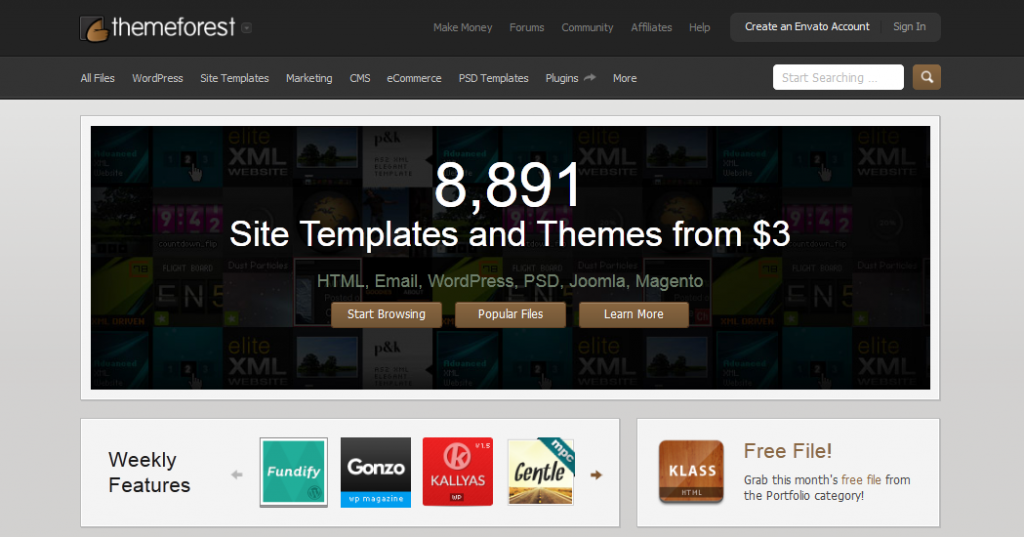Ensure that your work is presented to its best potential quality with these 11 really beneficial portfolio creation sites, chosen by users.
If you are an artist or designer, the World Wide Web is a vital place to display your work, offering a wide-ranging audience from prospective customers to friends to partners to utilize. Your portfolio reflects you and your job so it has to be just right, and easily accessible by everybody.
Luckily, there is no need to bang out — or gradually, stutteringly trudge outlines of code anymore. The below websites make it simple. Though if you are a coding whizz who wishes to dive deep in computer-speak, there are loads of websites for you too, like building craft sites.
A well-presented portfolio is vital if you are trying to get by in a visual business. We notice annually when it is a graduate season, just how easy it is to overlook job or recognition opportunities when you’ve got no website to follow up with after meeting someone in person.
Whether your portfolio-hosting website is an expansive social network or a more exclusive setting, it has to be just as stylish as your job to draw the attention you deserve.
After the newest upgrade of portfolio builder Cargo, we rounded up the best portfolio websites for artists and designers to showcase their work other than in a glass showcase.
Behance
More than simply being a go-to portfolio website for designers and artists – from animators to photographers, and everything in between – Behance is a really busy social network with job postings, remarks, the chance to follow artists gets you ‘enjoy’ on your job and even be a part of galleries.
Obviously, we have scrolled for miles on Behance. And so will many potential customers and collaborators.
It is ridiculously easy to register and upload your endeavours, and using a Behance is an essential for any new talent wanting to get noticed.
Adobe Portfolio
Behance Guru has made way for Adobe Portfolio, a platform where you can efficiently build a fully responsive website to showcase your creative work.
Everything is simple: pick a design, customise it — including your own domain name and Typekit’s library of fonts — and then sync with Behance. If you’re trying to create a complicated, highly personalized, this is not it. However, it does its assigned task nicely. Your website will automatically be optimized for any device, and you can use your own domain name, in addition, to having access to Lightroom photos and photography grids.
Additionally, using the pricier version, you have the whole selection of Adobe creative programs — from Photoshop to Illustrator. In the end, there are advantages to signing up with giant corporates.
Adobe Portfolio is free with Creative Cloud, together with access to the complete Typekit font library.
Wix
Wix is evolving and innovative, and we saw many new grads this year choosing it to get their own portfolios.
Wix has just introduced Wix Code, which basically gives complete creative and development control over to the person or business.
Wix Code will make creating standalone web apps easier for developers, painters, and photographers that are seeking to make an app tailored for their business requirements. Using JavaScript, it offers both front-end layout and backend functionality hosted in Wix Cloud, in addition to advanced features which were previously only available with custom style.
Wix Code supplies an integrated database and support for SEO, chance to customise data without having HTML or CSS — with the notion that attention can be spent in design templates and development rather.
Non-developers are able to benefit from databases, data-bound UI components and end-user custom forms and input controls with a simple drag-and-drop technique.
Wix is free, but premium programs provide more bandwidth, storage, no ads and much more. Although it caters to anyone who wishes to construct a website (which is pretty much everybody), it retains designers in mind as a target market.
Fabrik
Although new to the scene, Fabrik was created specifically for creatives to showcase their very best work, from display showcases to web pages, it has been curated from London’s design and film businesses, so we know it will do what artists’ want.
In its early phases, it created portfolio websites for production companies like Absolute Academy and Post and has since brought tens of thousands of jobs by designers, illustrators, studios, and filmmakers.
With Fabrik, you can select from over 9000 possible design combinations across different topics (and you can change these as frequently as you wish without affecting your job). The themes are tailored to different careers, so topics for designers by way of the instance will differ to illustrators.
Squarespace
 Squarespace is famous for its beautiful templates which will help to get you started using a more professional aesthetic to Behance or Adobe Portfolio.
Squarespace is famous for its beautiful templates which will help to get you started using a more professional aesthetic to Behance or Adobe Portfolio.
In addition to giving you the resources to create a site, with Squarespace you can monitor your audience and develop your social networking after.
Together with the responsive, sleek templates, the collection of free Typekit fonts and a curated set of Google fonts mean that there’s an enormous choice of fonts. Find out more about its features.
Squarespace offers both a private plan and a more expensive version for companies. Even though it’s slightly pricier than its rivals, it is geared more towards experts and is incredibly polished.
Portfoliobox
Designed specifically for creatives, Portfoliobox is nicely set up for galleries, blogs, e-commerce, gorgeous profiles and much more. It’s not difficult to navigate for those focusing on the visuals and has some truly beautiful portfolios to prove it.
Create and edit any kind of articles with no coding required, and a free domain name is included. Design your own templates and design and include free web hosting. Portfoliobox has no general theme that limits your layout — create as many pages of any kind as you require.
Cargo
Cargo is easy, powerful and shows off some truly terrific work — and it is recently upgraded with all new features.
Creating a website with Cargo 2 allows for a group of web pages, which may be edited or written just like writing an email or working on Google Docs. This makes it a good deal easier to drag and drop files in. Additionally, there are design tabs to your site’s universal layout settings and for each page. You could also try out a choice of premium typography from Webtype, Type Network and Google Fonts, new internal linking attributes and backdrops.
Because of the application process to obtain an account, its associates’ work is high quality and there’s a terrific community attached. Using its discreet, swish templates, you work will look much better on its own website. Unfortunately, however, portfolio customization is limited.
Implementing and signing up to a Cargo account provides you with a free basic service, which provides 12 jobs and 3 pages. Unless you operate a dainty portfolio, you will soon need to upgrade for unlimited pages and projects.
Format
Format has dynamic, superbly responsive topics (particularly with a cellphone). Format has a broad selection of pricing plans from private (100 pictures) all the way up to infinite (which, unsurprisingly, provides unlimited pictures — and custom HTML & CSS editing).
The format is excellent for the code-fluent and code-averse alike, with the choice to personalise web design or use built-in tools to modify your page. Additionally, it syncs beautifully with Adobe Lightroom via a plug-in.
Carbonmade
Carbonmade’s website might not be the sleekest or aesthetically pleasing at first website, but we were thoroughly impressed with their beautiful topics. As they explain it, “our stunning themes are so nice you will believe they’re Canadian.
Being a part of Carbonmade seems a good deal of fun. Created for designers, Carbonmade advantage comes from being tailored instead of a general website-building platform — with featured artist illustrations, in addition to gorgeous visual-based themes.
Moonfruit
Moonfruit has some pretty trendy, trendy and flexible template designs. Its blank canvas editor leaves room for imagination, but also space for bothersome misalignments — that blank canvas editors on competitions such as Wix do not suffer from.
Moonfruit provides everything from Google fonts to desktop animated effects and SEO-focused analytics. Endorsed by The Telegraph and The Guardian among others, Moonfruit boasts to be a fast way to make a gorgeous website.
Dribbble
Dribbble is a first and foremost a layout community in which all sorts of creative types discuss their work. It’s a wonderful place to research, learn and, of course, show off. The format is ‘shots’ — little screenshots of designs — so you may want another major portfolio site in addition to Dribbble.
But Dribbble is an amazing side-portfolio to create relations, see others’ work and learn. In addition to Behance, Dribbble is among the best places for inspiration online.
If you sign up to the expert program, you can chat more to designers, locate designers for hire and arrange your favorite designers in a listing.
Facebook
Google+
Pinterest








 shared interest. Think about what topic or theme that could bring your community together. Who are the people you wish join your forum, is it business management specialists
shared interest. Think about what topic or theme that could bring your community together. Who are the people you wish join your forum, is it business management specialists Squarespace is famous for its beautiful templates which will help to get you started using a more professional aesthetic to Behance or Adobe Portfolio.
Squarespace is famous for its beautiful templates which will help to get you started using a more professional aesthetic to Behance or Adobe Portfolio.

 69% of shopping carts on eCommerce shops are deserted. To resolve this issue, marketing automation software application has typically sent out e-mail blasts to recuperate these lost sales. However, what if somebody is unresponsive over e-mail?
69% of shopping carts on eCommerce shops are deserted. To resolve this issue, marketing automation software application has typically sent out e-mail blasts to recuperate these lost sales. However, what if somebody is unresponsive over e-mail? With marketing automation, you begin to gather substantial quantities of details about the visitors on your site regardless of whether it is their first time or they’ve had previous interaction.
With marketing automation, you begin to gather substantial quantities of details about the visitors on your site regardless of whether it is their first time or they’ve had previous interaction.